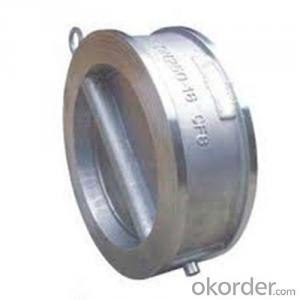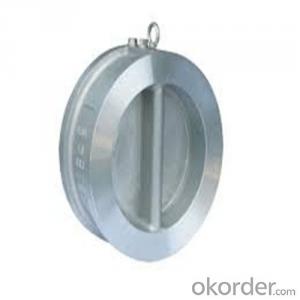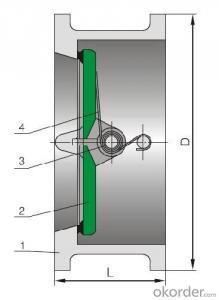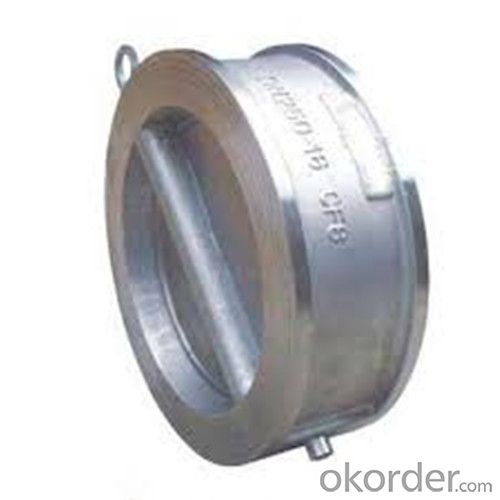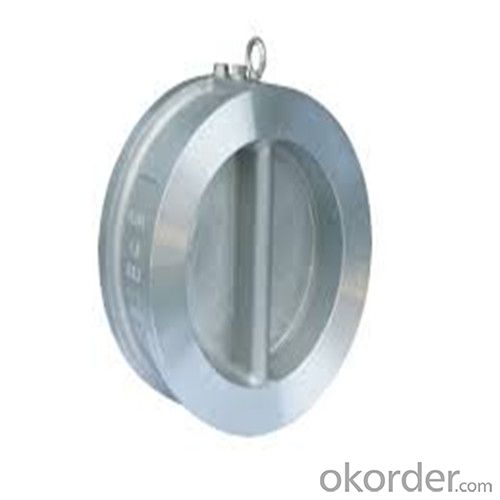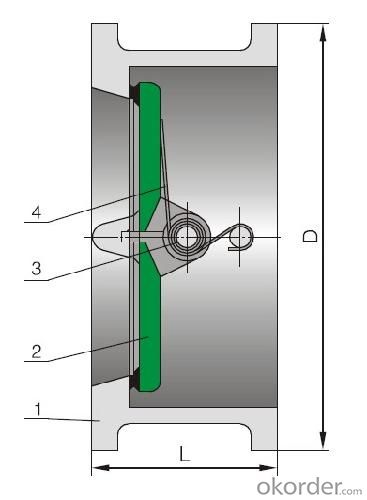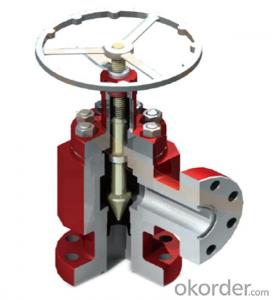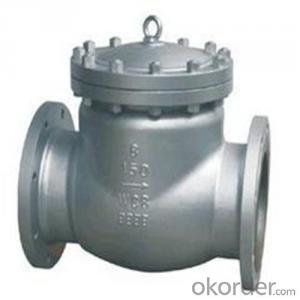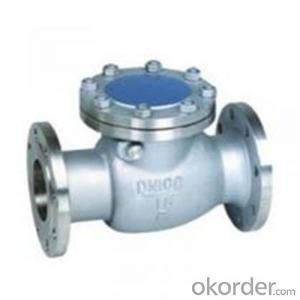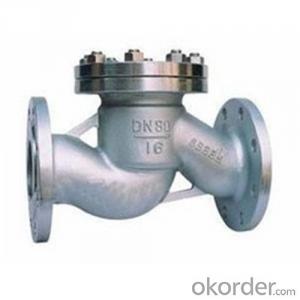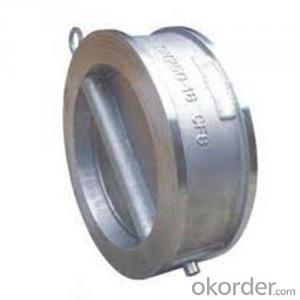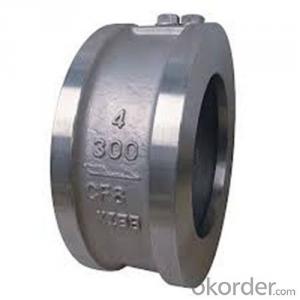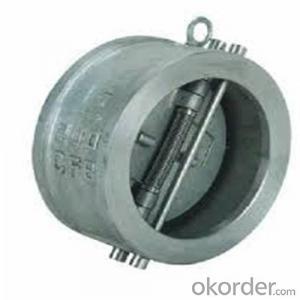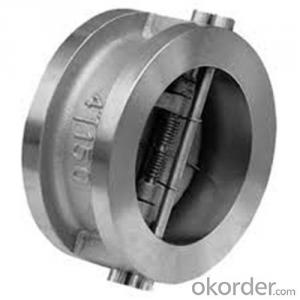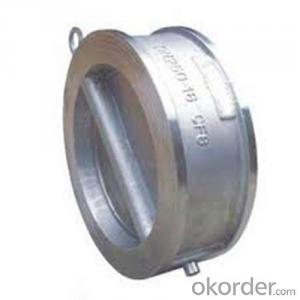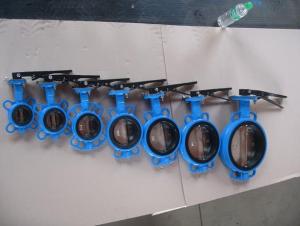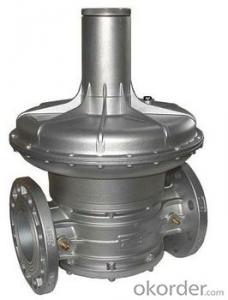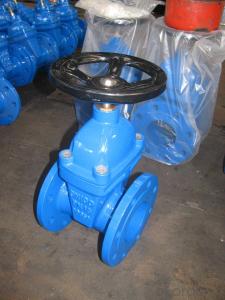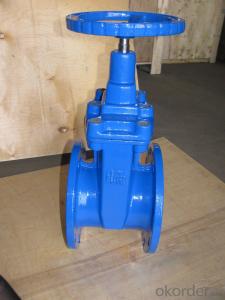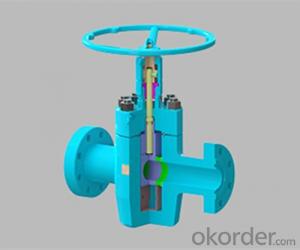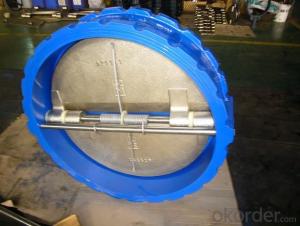Swing Check Valve Wafer Type Double Disc PN 6.4 Mpa
- Loading Port:
- Shanghai
- Payment Terms:
- TT OR LC
- Min Order Qty:
- 10 pc
- Supply Capability:
- 100 pc/month
OKorder Service Pledge
OKorder Financial Service
You Might Also Like
Products Description of Swing Check Valve
Check valves are used in pipes under pressures between PN1.6~16.0MPa(Class150~2500Lb), working temperatures-196~600℃, They are used in industries include oil, chemistry, pharmaceutical, fertilizer, and power gene-ration to prevent the backward flux of the media.
The main structure features of Swing Check Valve:
1、The products feature a reasonable structure, reliable seal, good performance and nice modeling.
2、Either soft or hard seal can be selected for the product upon different working conditions.The sealing face is built up with Co-based
carbide alloy, leaving a better wearability, corrosion and scrap resistance and a longer duration.
3、Small opening pressure, the disc can be opened fully with a very small pressure differential.
4、Inside-set bolt-bearing structure reduces leakage and reliable use.
5、PN≥16.0Mpa (class1500), the middle cavity uses a self-tightening sealing structure to have the sealing performance reinforced along
with the pressure rise so as to ensure the sealing performance.
6、Different parts materials and different sizes for flange, butt-welding are available for sensible combination according to different working facts and customers' requirements.
Parameter of Swing Check Valve:
Standard Criteria | GB customize |
Pressure Rating | 1 Mpa 1.6 Mpa 2.5 Mpa 4 Mpa 6.4 Mpa 10 Mpa 16 Mpa customize |
Valve Size | 50 mm 65 mm 80 mm 100 mm 125 mm 150 mm 200 mm 250 mm 300 mm 350 mm 400 mm 450 mm 500 mm 600 mm customi |
Actuator | Automatic customize |
Connection | Wafer customize |
Medium | Oil Steam Water customize |
Medium Temperature | -196~600℃ customize |
Structural style | Swing double-clack structure customize |
Application Fields | Agriculture Electricity Medical Petrochemical customize |
1-Body Material | CF3 CF8C CF8 WCB CF8M CF3M customize |
2-Disc | CF3 CF3M WCB CF8 CF8M CF8C customize |
3-Pivot | 1Cr13 1Cr18Ni9Ti 0Cr18Ni12Mo2Ti 2Cr13 customize |
4-Spring | 60Si2Mn 1Cr18Ni9Ti 4Cr13 0Cr18Ni12Mo2Ti customize |
Design Standard | GB/T 12224 customize |
Connection Standard | GB/T 9113 HG 20592 JB/T 79 customize |
Test Standard | JB/T 9092-1999 customize |
Face to Face | GB/T 15188.2-1994 customize |
Images of Swing Check Valve:
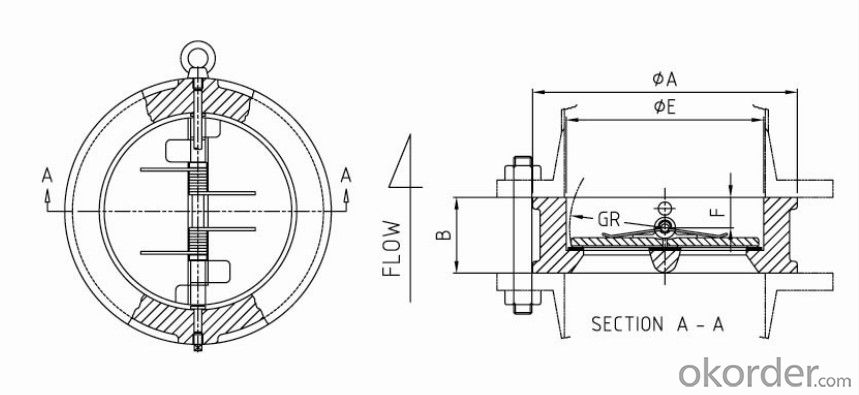
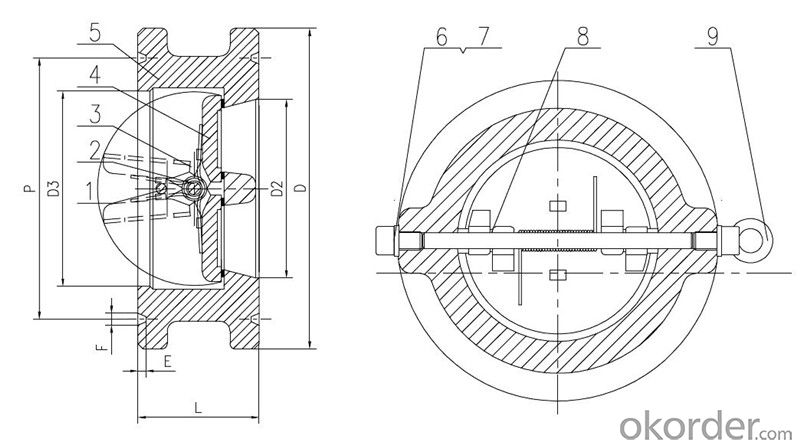
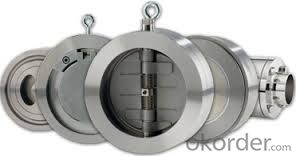
FAQ of Swing Check Valve:
Q1:I can’t find the type of steel check valve which I need. what can I do?
The chart above only lists out some common composition of steel check valve parts.We may provide other different parts material composition according to the customer's request or the actual valve working condition.
Q2:Which certification do your products pass?
Our products are in accordance with ISO 9001、ISO 14001、API 6A、API 6D、TS CE、API607/6FA/BS6755.
Q3:How can I place an order?
The only one thing you should do is to tell us the sepecification about type 、quantity and mode of transportation, then we will send you quotation within 24 hours.
- Q: From searching around I feel that I need to replace this on my vehicle. Is the Suction Control Valve different from the Idle Control Valve? Sometimes at a stop light the engine will stall. A couple times it has happened while driving when coasting to a turn or stop.
- I would think the suction control valve is what is also called a purge valve and is part of the emissions control circuit. It is not the same as an idle control valve nor will it cause poor running when it fails. The idle control valve will however..
- Q: 2004 R6. Runs really well... never had a problem. Has 24K miles on it. Yamaha calls for them to get readjusted at the 26,600 mile mark. So I have a few thousand more and then I'm gunna have them adjusted.I can already hear them tick especially at idle because when riding, my exhaust is so loud and all you can hear is that and the wind. Anyway, this time will come up before I know it.Just curious... what happens if the valves remain loose? Will it affect performance? How do you they become loose and is it ok to ride a bike with them like that... atleast until the specific mileage when they are supposed to be adjustd?
- could cause excessive crank case pressure if the duration is way off, i know from experience. Short valve duration=blow by because exhaust gasses have less time to escape the cylinder. Could potentially cause leaks due to blow by gasses
- Q: It started leaking slowly so I opened the release valve for about 20 secs than closed it back to see if that would help, but now it leaks even more. So I had to shut off the water that's coming into the water heater and know I can't use the hot water in my house. Can someone help me please!!!!
- Same thing happened to me.. The valve is probably older and needs replaced. Most likely dirt/sediment has reached the valve sea when you opened the valve. Solution: Replace Valve You will need: Pipe wrench teflon tape and a valve from the hardware store The valve is threaded into the tank. Turn water off to the tank and drain a few inches such that the valve is not submerged. Use the pipe wrench to remove the old valve. Replace with new valve (using teflon tape on the threads). Fixed!
- Q: How do I test to see if my gas valve on my wall heater is working or not? Please don't respond and say call a pro.
- I assume you mean the soleniod controlled valve. I also assume the pilot is lit, or the electronic ignitor glows (which ever it has) but the main burner doesn't lite. Use a test light (I prefer neon) or a meter to check the voltage to the soleniod. If the voltage never goes to 120, then there is something wrong upstream. If it does and the burner doesn't light, most likely the soleniod is bad. Also, you should hear it click when it opens and you should hear the gas.
- Q: my pcv valve tube is broken in half I replaced it with a rubber hose does it have to be whole
- no, i'm prety sure the pcv valve is to help the engine run smoothly. or something that has to do with the engine, i really dont think that is related to the tramsmission
- Q: A friend of mine who is 26, was just told by her doctor that she has aenlarged heart valve. Is this really serious? Will she need surgery? Why can't I find any info on the internet? Please help I'm really worried. Thanks
- I am a CCMA Look up the word Cardiomyopathy. This is the Medical Terminology for an Enlarged Heart Valve and Yes it is VERY serious. Best Wishes
- Q: I am doing a big project on Valve and it's games. I am currently doing some research on the company and wanted to see if anyone had any interesting facts or information about Valve that may be useful when doing research, thank you. :)
- Valve = Steam. Research Steam and you research Valve.
- Q: had a water heater put in after that i have low hot water pressure it get hot but goes to a low stream.when i try to adjust gate valve it keeps turning
- freeze the line coming to the valve, with a co2 fire extinguisher, or dry ice, then swap the valve, and let it thaw
- Q: if i put a power valve on my honda xlr 125 would it make my bike have faster acceleration
- Does not apply to 4 stroke motors.
- Q: Hi, I'd like to control a three way solenoid valve like this one:understanding is that an electric current through the solenoid will cause the valve to let air one way while no electric current will have the air flow the other. Is there a piece of equipment like a control box (that can communicate w/ a computer) that would allow me to control the solenoid valve like this? and if so, where would i be able to find something like this....i've googled but no success. I eventually want to control the valve from a computer. Thanks
- There are dozens of valves on that link, you have to be more specific. Most valves switch between open/close with application / removal of electrical power. Restricting air flow to one direction is done via a check valve, not something that requires power. Air flow will be from the direction of higher pressure to lower pressure. A valve can stop that flow, it cannot reverse it. You can control the valve with a relay, and that with relay driver IC such as a ULN2003, and that driven by a computer. Depending on the power levels, you may be able to drive the relay directly from the relay driver. .
Send your message to us
Swing Check Valve Wafer Type Double Disc PN 6.4 Mpa
- Loading Port:
- Shanghai
- Payment Terms:
- TT OR LC
- Min Order Qty:
- 10 pc
- Supply Capability:
- 100 pc/month
OKorder Service Pledge
OKorder Financial Service
Similar products
Hot products
Hot Searches
Related keywords
